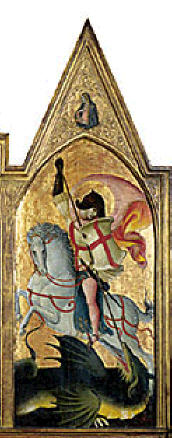Giovanni dal Ponte [Giovanni di Marco] was born in Florence at 1385 and died in Florence, 1437–8). It's said, that he had been a student of Spinello Aretino. He took the name dal Ponte due to the location of his studio at Santo Stefano a Ponte in Florence. He joined the Arte dei Medici e degli Speziali in 1410 and the Compagnia di S Luca in 1413. In the mid 1420s he had debts and even was prisoned in the matter. In the end of the 20ies 1420s he opened his own studio and formed a partnership with the painter Smeraldo di Giovanni (c. 1365– after 1442). His work included fresco cycles, panels and the decoration of small objects. A number of allegorical panel paintings and cassoni are attributed to him, under them the Seven Liberal Arts (1435; Madrid, Prado) in a garden with naturalistic flowers and plants.
When we get better informations, we will improve the article. Raimondo Luberti gives as his source:
Luciano Bellosi. Come un prato fiorito. studi sull'arte tardogotica. Jaca Book. Milano 2000 p.200-201 et ill. 266-272, as main source about Giovanni di Marco F. Guidi: Per una nuova cronologia di Giovanni di Marco in "Paragone" n.223, 1968 pp. 27-46 et n.239, 1970 pp.11-23.
An earlier dating of the Rothschild cards wouldn't take an effect on our special theories about the year 1441 and the 5x14-deck. The only sure trump card in the deck is the Emperor and the Rothschild cards might be the fragment of an Imperatori-deck at least as well as it might be the fragment of a Trionfi deck. Imperatori decks are first mentioned in 1423 as "from Florence" and Giovanni dal ponte is a painter from Florence.
As Giovanni is mentioned as used in the decoration of "small objects" (playing cards are small objects), as "having debts" (it probably were not the best paid artists, which made playing cards, although there are exceptions) and as used to "allegoric objects" (7 artes liberales), it seems, that he might well have been a painter of playing cards.
